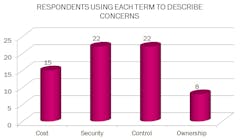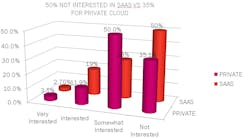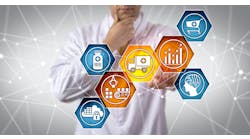What Do You Really Know about Cloud ERP?
Let’s face it, the concept of cloud computing is confusing. And the idea of deploying enterprise resource planning (ERP) software in the cloud just adds to the confusion.
If a vendor manages the software, how does this impact control over and ownership of the data that resides on those systems? Are there obligations to preserve the data after the termination of a contract?
Issues around cloud ERP become clearer once we define key terms, including: software as a service (SaaS), public cloud and private cloud. To do so, we will draw from experience as well as from a recent study on cloud ERP conducted by IFS North America.
#1: What is Cloud?
First and foremost, cloud is a way to provision computing resources. Vendors and analysts put their own spins on cloud to suit their needs. Let’s cut through the hype and source our definition from the National Institute of Standards and Technology (NIST) -- part of the US Department of Commerce. NIST identifies five essential characteristics of cloud:
- Computing capabilities are accessible on-demand. This means that a customer can unilaterally provision resources without human intervention by the service provider
- Computing capabilities are accessible through broad networks (i.e. the internet) and on any device (e.g. smartphones, tablets, and PCs)
- Computing capabilities are pooled to service multiple customers.
- Computing capabilities are rapidly elastic allowing for on-demand scalability.
Computing services are measured, meaning that the service provider leverages metering technologies to automate the control and optimization of cloud resources. In contrast, running software on traditional servers saddles a company with an increased burden to administer IT infrastructure and manage capacity.
Inadequate server capacity can result in performance issues. Excess server capacity can result in sunk costs. Running ERP in a managed cloud environment mitigates many of the capacity issues. It also releases the end user organization from many of the IT administrative tasks.
#2: SaaS: Subscription Model Cloud Software
By definition, SaaS is a vendor application that is deployed on cloud architecture. Most typically, vendors deploy SaaS as a single application that is shared by multiple customers. Multi-customer sharing component is what is referred to as “multi-tenancy.”
SaaS software solutions remain owned, managed and controlled by the software vendor. By providing access to their own software, vendors are in effect offering it “as a service.” SaaS solutions are most typically offered as a rental in exchange for recurring subscription payments.
In contrast, vendors of on-premise software sell a perpetual license to use their software. This licensing model involves a transfer of rights as consideration for a one-time payment by the customer.
There are several prominent SaaS-related myths. One such myth is that SaaS solutions are inevitably less expensive than on-premise solutions.
The real answer is “it depends.”
It depends on the particular circumstances as well as the time horizon at issue. On-premise licenses typically allow a buyer to use the software in perpetuity. In contrast, a SaaS vendor typically doesn’t require an up-front capital expenditure for the right to use the software (although a one-time implementation service cost will apply). Rather, the consideration for a right to use a SaaS application is the recurring subscription payments that are treated as operating expenses, and not as a capital expense.
In many cases, the time horizon plays a material role in TCO (total cost of ownership) value when a company uses software beyond a typical 10-year ownership period. Many companies don’t rip and replace an ERP system after 10 years if the system continues to deliver meaningful value. When ownership cycles extend beyond a standard lifecycle, on-premise systems generally deliver lower TCO than their SaaS counterparts.
It is important to note that SaaS and associated subscription payment-models are not the only ways in which software is deployed in the cloud. For example, perpetually licensed ERP can be deployed in the cloud. For many companies, this type of approach delivers many the cost benefits relating to IT administration in the cloud while mitigating some of the control, ownership, and long-term TCO issues associated with SaaS.
Another common myth is that data held in a SaaS application is less secure than data held in an on-premise environment. Once again, the true answer is “it depends.”
Businesses should evaluate the physical and security policies and procedures of the SaaS vendor and compare those to its own capabilities. Generally, however, many SaaS vendors offer levels of encryption that would provide a high degree of security. Even Dilbert creator Scott Adams makes this point to humorous effect.
#3: Private Cloud: Best of Both Worlds?
As discussed above, SaaS is one method to deploy software in the cloud. In the recent IFS North America study, respondents said their chief concerns about SaaS-based ERP related to control over and ownership of the application. Companies with these concerns might consider a private cloud model that allows them to retain control.
So, what is private cloud? In a private cloud environment, a company deploys software on its own computing resources – resources that it does not share with the public at large.
There is nothing inherent in the five-pronged NIST definition that requires cloud computing resources to be broadly available. In a private cloud deployment, a company can provide software access to its multiple business units or divisions. In many cases, companies deploy their perpetual license-based ERP software in this manner.
There are other advantages to private cloud, including an ability to configure and tailor the software to meet specific customer requirements, such as customized enhancements, workflows, integrations, and other bespoke requirements that may be difficult or impossible to achieve in a shared-use or SaaS-based model.
Enhanced control was a perceived benefit of perpetually licensed software among IFS study respondents.
In response to an open-ended question, many respondents cited control as a primary concerns with SaaS applications. Examples of control include an ability to make decisions about how to configure the software, when to upgrade, and when to roll out new functionality.
SaaS vendors, for instance, upgrade the software centrally, and position the fact that all users are always on the latest version as a product benefit. But new versions mean change, and change can be disruptive. If a centralized upgrade happens at a mission critical time for one’s business, one may feel like he lacks control.
#4: Cloud Benefits
Private cloud might become the preferred way to leverage the flexibility and scalability of the cloud in provisioning ERP, particularly for far-flung global organizations that operate in a 24x7 environment that requires around-the-clock IT administration.
In a smaller organization, a single individual or fractional position is oftentimes responsible for all of the various technical support and administrative roles to support an on-premise instance of ERP. But that one employee needs to sleep and have a life outside of work. He also needs to take vacations and an occasional sick day.
In a private cloud environment, the managed service provider is responsible for providing most administrative and support roles 24x7. In many cases, this can result in a cost savings relative to an on-premise solution, as well as enhanced operational and IT risk management.
Implementing in a private cloud can drive additional cost savings as compared to on-premise deployments. On-premise hardware configurations differ widely from one customer to the next. Consequently, implementations of on-premise solutions typically include an IT infrastructure and special projects phase. Companies can avoid costs and time associated with hardware configurations and software deployment by leveraging pre-configured hardware in a private cloud environment.
Conclusion
Clarifying the differences between cloud, SaaS, on premise and private cloud is critical. The IFS study data suggests that substantial confusion exists, particularly with respect to SaaS. For example, in response to one questions, 5% of respondents indicated that they are leveraging SaaS applications.
In a separate and differently worded control question, 20% of respondents stated that they are running SaaS ERP. This discrepancy suggests that there is significant confusion regarding the SaaS software and deployment models. SaaS does not equal cloud, and respondents may be thinking that any cloud solution is SaaS.
Hopefully, at least for you, we have eliminated much of this confusion. We trust that you now have a broad understanding of cloud ERP, SaaS ERP, and perpetually licensed ERP delivered through a private cloud.
Rick Veague is chief technology officer for IFS North America, and is based in the Itasca, Ill. headquarters. In this role, Veague provides direction for IFS’ use of Service-Oriented Architecture (SOA) and works with IFS Applications leading users throughout North America to leverage SOA to provide state-of-the-art ERP.
Jonathan Gross is director and legal counsel at ERP consultancy Pemeco, where he leads enterprise software strategy and selection projects.






